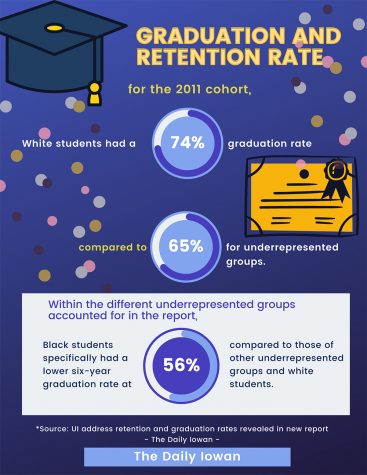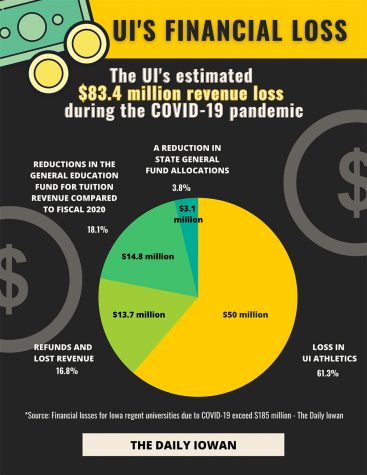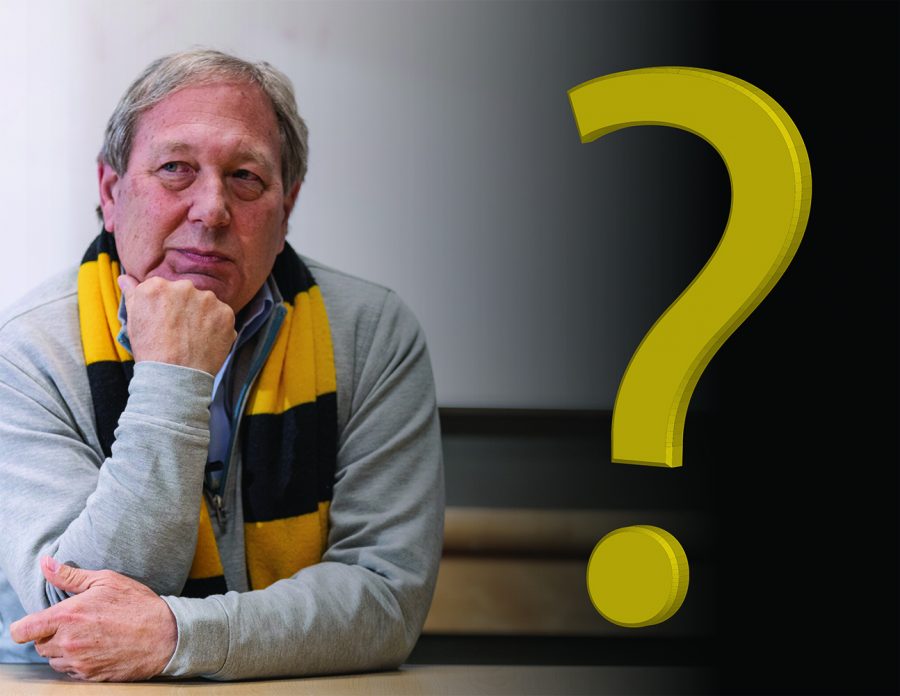Illustration by Kate Doolittle
Opinion | The ideal candidate for the next head Hawkeye
Members from the DI Opinions section outline what priorities and qualities we would like to see in the next UI president.
March 30, 2021
Introduction
In October 2020, University of Iowa President Bruce Harreld announced his retirement, igniting the start of another search for a new campus leader. With this search comes the question of who is fit to lead a university facing numerous challenges from the past year: the loss of millions from the COVID-19 pandemic, a newly framed emphasis on diversity, equity, and inclusion, and climate change.
In the presidential search that selected Harreld, the Harvard Business School graduate was the last choice for multiple community members of the UI because they’d envisioned someone from the academic stratosphere as a best fit for the position.
Because of his business background —Harreld had served in the upper administration of IBM and Boston Market company — UI faculty members didn’t believe he was qualified to lead an academic institution.
Survey results released the night before Harreld was chosen had him ranked last by UI community members. Nevertheless, the state Board of Regents voted unanimously for him to take the coveted office.
With the current search, this gives the opportunity for the university to have a fresh start.
The most obvious question to come now that the search process is in full throttle — who is going to be the UI’s next leader? However, the more important question that comes to mind is what their priorities and goals should be. What their values and priorities are will determine how they will tackle various issues such as financial loss, DEI efforts, campus sustainability, and shared governance.
The Daily Iowan Opinions staff outlined the ideal candidate for the next leader at the university and how they should address hot-button topics in order to steer the university in the right direction.
DEI Initiatives
As the search commences for the next UI president, it is crucial to reflect on diversity, equity, and inclusion efforts within the university. Furthering diversity, equity, and inclusion is essential, not only in diversifying viewpoints and opinions but also in ensuring underrepresented populations have mentors and peers that hold similar identities and can connect to their experiences.
A big concern in regard to diversity, equity, and inclusion is supporting and retaining staff and students of color. In the 2020 Campus Climate Survey of faculty, staff, and post-doctoral students, the UI found underrepresented groups reported lower levels of satisfaction and a higher likelihood of considering leaving the UI in the past year. About half of underrepresented racial groups and Latinx respondents considered leaving the UI in the past year, nearly twice as high as Asian respondents, at 26 percent, and higher than overall at 41 percent.
As previously reported by The Daily Iowan, Shalini Jasti, a senior student in the English department, reported concerns over losing five Black professors in the past few years. The larger issue is that the university struggles to support and retain staff and students of color.

According to data reported by a UI taskforce in 2019, only 3 percent of students at the UI are African American or Black. In contrast, 8.5 percent of the state of Iowa’s population was Black as of 2020. The UI plans to conduct a student campus climate survey later this semester.
It is not surprising that the Black population at the UI would be lower than that of the state. However, we need to do a better job recruiting and sustaining underrepresented populations.
Michael Warner-Craft, a junior at the university studying ethics and public policy, is involved in several organizations including serving as the president of the Black Student Union on campus. Warner-Craft shared a similar sentiment regarding the ways we need to better serve students and staff of color.
“I think most importantly they need to be a lot more intentional about the recruitment and retention efforts that they’re doing,” Warner-Craft said. “There’s a plethora of Black people in the Coralville and Cedar Rapids surrounding area. Why are they not being recruited as heavily as students from Illinois? We need to be tapping into the resources we have here.”
Not only are there discrepancies in Iowa’s recruitment efforts but also when looking at the graduation rates of different populations.
There are significant gaps in college graduation rate for Black students versus their white counterparts. Data from a 2018 regents’ report showed the four-year graduation rate for white students was 74 percent, while their Black peers were graduating at a rate of 56 percent.
Iowa needs to focus on amending these disparities and look into ways we can better serve students, faculty, and staff of color. Warner-Craft suggested how we need to be better supporting students through better supporting our cultural organizations.
“It’s extremely difficult for student organizations like BSU [Black Student Union] and ASA [African Student Association] to acquire funding for events, especially when they have to go to USG [Undergraduate Student Government] with fewer members than other student orgs because we don’t have that kind of student representation,” Warner-Craft said. “That doesn’t mean we deserve less funding.”
Tabitha Wiggins, interim director at the UI Center for Diversity and Enrichment, also stressed the importance of supporting students and staff of color.
“We have a ton of data where BIPOC students and staff have shared their experiences,” Wiggins said. “We need to be looking at that data and making data-informed decisions around how to not just recruit but retain people, looking at what barriers people are facing that prevent them from growing and developing, such as tenure and promotions.”
Until the installation of Liz Tovar as the permanent executive officer for diversity, equity, and inclusion this semester, the three-unit division faced fast-paced administrative turnover. In February 2020, TaJuan Wilson left his position as Associate Vice President of Diversity, Equity, and Inclusion just seven weeks after starting the job. Before his brief tenure, two interim officers filled the role after Georgina Dodge stepped down in 2017, and it was left vacant until the summer of 2020, when Tovar was named interim after a sharp letter from the UI Diversity Councils criticizing the continued vacancy. Lena Hill, former director of the Center for Diversity and Enrichment, also stepped down this summer, and was replaced by Wiggins as an interim director.
In December 2020, Jessica Paige, an assistant professor of Sociology and African American Studies, voiced her frustrations with the UI’s response to diversity, equity, and inclusion at a UI Faculty Senate meeting, after she said she and other faculty of color weren’t included in forming a 14-point plan and overall inclusion efforts.
In an interview in the days following the meeting, President Harreld said the UI conducted several town halls and small group meetings with stakeholders across campus in developing its strategic plans, and said he would be happy to sit down for a meeting with anyone who felt left out.
Paige said at the time that she wouldn’t recommend other people of color to work at the UI because of the turnover in the three-unit division of diversity, equity, and inclusion. At the meeting, Paige also said during the meeting she planned to leave at the end of the year. Several other faculty members at the meeting expressed their support of what Paige and another faculty member had voiced regarding DEI efforts.
Since then, the UI — led by Tovar as the newly permanent executive officer for diversity, equity, and inclusion — launched its “Journey to Unity” campaign, which includes trainings on creating a more just and inclusive campus, and recruitment and retention programs.
The university has a lot of work to do in order to better uphold diversity, equity, and inclusion efforts. Students and staff of color should not constantly have to fight to put together equitable and supportive systems for them to work. We need a president who is willing and able to look into the many barriers underrepresented groups face and take the necessary steps to break them down without hesitation.
Sustainability
Throughout Harreld’s tenure, there appeared to be a serious lack of initiative when it came to the university’s efforts in sustainability. In 2019, Harreld declared that we are facing a climate crisis, but neither he nor the UI community prioritized following up. Moving forward, there must be concrete action to address ways in which we as students, faculty, and staff can come together to tackle ambitious goals that will create a more sustainable campus.
The UI has taken steps such as creating a sustainability task force and outlining sustainability goals for the next 10 years. Thankfully, the UI met its original 2020 goals such as using less energy and receiving 40 percent of campus energy from renewable resources such as water, solar, and air. But it did not achieve the great majority of their original plans for 2020 set back in 2010.
There are some parts of the UI that do not help the push for sustainability — the various guilt-tripping signs about food waste in the dining halls and the coal-burning power plant next to the Campus Wellness and Recreation Center, which burns 50,000 tons of coal each year.
Furthermore, the UI failed to achieve its 2020 goal of diverting 60 percent of campus waste from the landfill. Part of this problem stems from the dining halls, where the greater majority of food waste generated on campus stems from.
There are various clubs and programs led by students, such as the UI Environmental Science club and the UI Gardeners, but there is little impact on the greater university except for the posters in the dining hall telling students about how much food they are wasting if they do not eat everything on their plates.
Those signs do not mean anything. It is not food waste by students who do not finish their meals that is the worst cause of food landing in the trash. It is when the dining hall miscalculates and makes too much food for the designated meals. All of the pans sitting in the warmers ends up in the compost bin in the back of the building, but not before it is weighed to tally the waste pound for pound for the mealtime.
David Cwiertny, UI professor of civil and environmental engineering, offered his similar opinions on the university’s approach toward sustainability.

“We have a rich history to achieve sustainability; we have to be upfront as leaders,” Cwiertny said. “But we’ve missed the opportunity to become leaders as a university. Even when we do well, we don’t market the achievements.”
Much of the call for change has come from students. In 2019, international climate activist Greta Thunberg drew more than 3,000 members of the Iowa City community to a rally downtown, which included many students. Student organizations such as the UI Environmental Climate Coalition dedicate themselves to protecting and caring for the environment, like the Reusable Water Bottle Exchange, in which members exchanged plastic water bottles for reusable ones.
However, sustainability efforts must be prioritized from the top administration, and that starts with the president.
Harreld needed to be more vocal as a president in combating the climate crisis. The efforts should come from the top down, too, not solely from a few students passionate about the problem.
“Sadly, sustainability is linked to climate change, which is a political topic for most people,” Cwiertny said. “The university is not vocal about our efforts for fear of scrutiny.”
Half measures are not getting the job done anymore. The next head Hawkeye needs to take a proactive stance on sustainability, instead of working in the background and hoping that others will do the work for the UI. Our generation of students have proven they want to be a part of the solution. But leadership should come from the top.
Shared Governance
No matter who is picked to take up the office at Jessup Hall, the chosen candidate must be supported and approved by shared governance.
When Harreld was hired, members of the Faculty Senate — one of the UI’s shared governance leaders — were extremely disappointed after expressing their lack of support for Harreld.
Once the regents made their unanimous vote for Harreld, the Faculty Senate submitted a “no confidence” vote in the regents.
But it wasn’t just members of the Faculty Senate that expressed disapproval. After Harreld was hired, the American Association of University Professors released a report that condemned the UI’s hiring process. The report blasted the regents for blatantly disregarding university governance and committing a disservice to the institution.
For the current search, one of the key components is inclusivity. As previously reported by The Daily Iowan, John Keller — co-chair of the Presidential search committee and future interim UI president — stressed that transparency and broad representation from all groups on campus was essential to the process.
The search committee is composed of 21 members and includes representation from all four branches of shared governance, which are campus-wide shared governance bodies, departmental/college shared governance bodies, and UI councils and associations.
In December 2020, the committee held listening sessions for faculty, students, and staff so they could share input on the search for the next president. Later on, they created a job description with preferred qualities that included a doctoral degree and experience with an academic center.
Joseph Yockey, UI Faculty Senate president and UI College of Law professor, stressed that shared governance is a positive force because it builds bridges between administration and the UI community and leads to better university decisions.
Yockey said Faculty Senate officers are pleased with and feel included in the current search. Multiple senators are on the search committee, and the co-chairs took time to talk with members beforehand to ensure the most credible process.
In the current administration, Yockey appreciates the transparency and accessibility from university leaders — qualities he would like to see continued in the next leader.
In addition, Yockey said he hopes that the president can inspire confidence and empathy in light of a tough and challenging year.
Overall, Yockey has been pleased with the inclusiveness and collaboration between the Faculty Senate and the search committee for the current search.
“We’re still in the middle of the process, so this could change I suppose about how things progress from here,” Yockey said. “But, up until now as a Faculty Senate officer, I’ve been pleased with [how] the Board of Regents, the regents on the search committee, and the members of the search committee have been working together.”
The search committee must continue the positive relationship with shared governance groups if the UI wants the best choice for the next leader of the UI.
“I have no reason to doubt the mindset of the regents in terms of how they’re approaching this search,” Yockey said. “It seems to be proceeding as well as any of us could’ve hoped for.”
When the next president takes office, Yockey believes there needs to be a greater emphasis on philanthropy and finances — especially with the financial losses from the COVID-19 pandemic, which number in the millions. Another financial issue that needs to be addressed is how the UI lags behind the median salary for college faculty.
According to the Integrated Postsecondary Education Data system, the average salary for a full-time professor was $142,848, compared to the comparison group median of $149,402 for the 2019-20 year. Associate professors had an average salary of $94,857, while the comparison group median was $102,465, and assistant professors made $82,627, compared to the comparison group median of $93,321.
Yockey stressed that the next administration should focus on retention and recruitment as well, and part of that falls on improving university salaries.
The next UI president must understand and work closely with shared governance bodies. Yockey added that shared governance leads to better decision making and engagement with the community. The new president must have a commitment to hear out their fellow leading Hawkeyes for the UI to make the best decisions for the community.
Financial Loss
Interconnecting with everything else, the next head Hawkeye must face navigating the UI’s financial future — a worrisome road ahead compounded by the losses of the COVID-19 pandemic and decreased state funding.
There is no question whether the UI is struggling financially. Refunds, health precautions, and building improvements have contributed to over $185.63 million lost by all three Iowa public universities since March 2020.
The UI has lost around $83.4 million, with over half lost from athletics, $13.7 million in refunds and lost revenue, and reductions of $14.8 million in the General Education Fund for tuition revenue.
Tuition revenue loss is partly because of the decision made by the regents in June 2020 to freeze tuition for the 2020-2021 academic year. The regents are expecting to resume gradual tuition hikes in future years. Additionally, the four-year decline in student enrollment, which is expected to continue, has also contributed to a loss in revenue for the university.
The effects of the financial loss have affected multiple parts of the UI.
The UI plans to discontinue men’s gymnastics, men’s swimming and diving, and men’s tennis programs after the 2020-21 academic year. Women’s swimming and diving is temporarily reinstated. Other sacrifices the athletic department made included cutting 40 positions to make up for the loss from the COVID-19 pandemic.
In addition, the decrease in state funding has taken a toll on the UI. State government has ignored multiple calls for increased aid.
In summer 2020, the regents requested an $18 million increase for the fiscal 2021 year. Instead, the Iowa Legislature cut funding for all three public universities by $8 million.
In the state budget proposal for 2021, Iowa Gov. Kim Reynolds refused to meet the university leaders’ request by $11 million. However, this underfunding represents the bigger trend of a decrease in funding for higher education, despite the state budget doubling over the past two decades.
With the lack of state aid and significant financial loss, it’s clear the UI must look for alternate ways for funding the institution. The university already made enough sacrifices when it laid off 15 faculty members from the College of Liberal Arts and Sciences in summer 2020.
Although five of those faculty members were reinstated, it should not be ignored that the UI still experienced a loss in the quality of its education as a result of budget cuts.
The UI cannot make any more decisions that would affect its status as a top-tiered academic institution.
The next president must prioritize looking for alternate funding to keep the UI from having to make any more sacrifices, such as faculty layoffs and cutting sports. These alternatives could include creative methods, such as the UI’s recent agreement with the Follet Higher Education Group for a private partnership with the UI Hawk Shop.
Sally Johnstone, president of the National Center for Higher Education systems, stressed that the next leader must develop new strategies for financial stability instead of operating as “business as usual.”

Johnstone said the financial crisis at the university was an issue prior to the COVID-19 pandemic.
According to the High School graduate projections from the Western Interstate Commission for Higher Education, there has been a decline in graduates attending college. Iowa continues to lose people, so the UI strategy has aimed to attract students from other states, such as Illinois.
According to Johnstone, Illinois is going to experience a decline in graduates between 2019-37, so the state is looking for ways to keep students within Illinois borders for higher education. That strategy will make it harder for the UI to attract students from other states, thus contributing to financial loss.
When COVID-19 hit, Johnstone said the pandemic only accelerated financial loss trends at higher education institutions. She said she believes universities would have made pandemic-induced cuts such as faculty layoffs and sport discontinuation down the road anyway.
“The pandemic accelerated ongoing trends,” Johnstone said. “I would suggest these things were going to happen anyway, maybe three or four years from now. But it all came together at once.
Johnstone said increasing tuition costs isn’t going to make up for losses, and the U.S. has reached a tipping point for student debt.
“Increasing costs offset by higher student tuition isn’t going to cut it,” Johnstone said. “That’s the typical approach over the last several decades universities have used, and it’s also the rationale state legislators use for budget cuts. They can’t cut as much for K-12 funding because there’s no alternate source of revenue. But for colleges and universities, they can charge higher tuition.”
Additionally, the COVID-19 pandemic has dissuaded potential students from taking on debt, leading in part to a decrease in enrollment at universities.
The UI must continue to develop new strategies to bring in revenue, and the next president must take charge in these changes, especially in the long term.
Johnstone emphasized that the long-term strategy is moving away from the mindset of competition, and instead focusing on appealing to students by offering support and programs where they will be successful. This includes implementing degrees geared toward Iowa’s needs and developing relationships with outside sources, so students have connections for their career after college.
By changing recruitment strategies, this will also open the door for new revenue sources such as private/public partnerships.
“The idea of finding other institutions, whether it’s inside or outside the University of Iowa, can collaborate to reduce the costs of operations will be the key to the future,” Johnstone said.
Additionally, the president needs to stress the importance of higher education institutions. The Iowa Legislature is famous for micromanaging higher education, and our next leader needs to hammer everyone over the head with the benefits the UI brings to the state, and talk with lawmakers in Des Moines. Otherwise, we only invite more micromanagement.
Prioritizing financial loss includes changing the structure of the UI instead of just increasing tuition that falls on the backs of students and families.
This includes the long-term change in recruitment strategy, greater collaboration, and finding institutions outside of Iowa to reduce the cost of operations. If the next president throws money at normal structures, then the UI is going to face the same financial difficulties.
